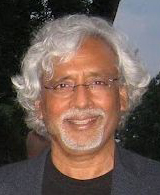 M. Zafri Humayun, Ph.D. M. Zafri Humayun, Ph.D.
Professor
Office: ICPH-E450V
Tel: 973-972-6396
Lab: ICPH-E430L.2
Tel: 973-972-5217
NJMS Faculty Profile
|
Fidelity of DNA Replication
To become cancerous, a cell needs to acquire multiple mutations, perhaps as many as 6 or more. Mutations occur at a canonical rate of 10-6 per gene per replication cycle. So, the probability of a cell becoming cancerous by acquiring 6 mutations is 10-36. This calculated number is so small that theoretically no human should get cancer! Nonetheless, cancer is a common human disease, accounting for about a third of deaths in the United States. A way to resolve this"mutation-rate paradox of cancer" is to propose that mutation rates can increase well above normal levels in cells destined to become cancerous. Cells displaying increased error levels are called mutator cells. Mutator phenotypes can arise by the loss of a gene required to repair DNA (called permanent mutator phenotypes), or as a regulated response to changes in environmental or physiological conditions (called transient mutator phenotypes). Transient mutator phenotypes are particularly interesting because any replicating cell can experience episodic mutation bursts, a scenario that offers a more satisfying general solution to the mutation-rate paradox of cancer, as well as to other biological situations where there is a seemingly inexplicable increase in mutation rates. Our laboratory discovered, or co-discovered two transient mutator pathways termed UVM (for UV modulation of mutagenesis) and TSM (for translational stress-induced mutagenesis).
UVM, a pathway that is distinct from the bacterial SOS pathway, is induced when cells are subjected to DNA damaging treatments such as irradiation with UV. UVM appears to affect translesion DNA synthesis and appears to be mediated by an error-prone DNA polymerase whose identity has not yet been determined. The TSM pathway, identified by us based on results from other labs as well as ours, is triggered, surprisingly, by increased mistranslation, and affects mutagenesis at undamaged as well as damaged DNA templates. Expression of a variety of mutant tRNAs, as well as exposure of cells to streptomycin (an antibiotic that enhances mistranslation) can induce the TSM phenotype. The TSM response appears to be mediated by an altered form of the major replicative DNA polymerase, namely, DNA polymerase III. More recently we have looked at mechanisms that generate transposon-insertion mutations in response to environmental conditions such as starvations stress. We find that starvation can affect DNA conformation at specific genes such as to enhance transposon insertion, which in turn enables cells to survive by utilizing alternative sources of energy.
Selected Publications
- Humayun M.Z., Zhang Z, Butcher AM, Moshayedi A, Saier MH Jr. (2017) Hopping into a hot seat: Role of DNA structural features on IS5-mediated gene activation and inactivation under stress. PLoS One. Jun 30;12(6):e0180156. doi: 10.1371/journal.pone.0180156. eCollection 2017.
- Zhang, Z., Kukita, C., Humayun, M.Z., Saier, M.H. (2017) Environment-directed activation of the Escherichia coli flhDC operon by transposons. Microbiology. 163(4):554-569.
- Humayun, M.Z. and Ayyappan, V. (2013) Potential roles for DNA replication and repair functions in cell killing by streptomycin. Mutation Research 749(1-2):87-91.
- Gautam S, Kalidindi R, Humayun, M. Z. (2012) SOS induction and mutagenesis by dnaQ missense alleles in wild type cells. Mutation Research 735(1-2):46-50.
- Al Mamun A.A. and Humayun, M.Z. (2009) Spontaneous mutagenesis is elevated in protease-defective cells. Molecular Microbiology 71(3):629-39.
- Al Mamun, A.A., Gautam S., Humayun, M.Z. (2006) Hypermutagenesis in mutA cells is mediated by mistranslational corruption of polymerase, and is accompanied by replication fork collapse. Molecular Microbiology 62:1752-63.
Education
Ph.D., 1975, Indian Institute of Science, Biochemistry & Molecular Biology
M.Sc., 1970, Madras University (JIPMER campus), Medical Biochemistry
B.Sc., 1967, Andhra University (Loyola campus), Chemistry & Biology
Positions
1989-Present. Professor, Department of Microbiology and Molecular Genetics, Rutgers New Jersey Medical School, Newark, NJ
1983-1989 Associate Professor, Department of Microbiology and Molecular Genetics, UMDNJ-New Jersey Medical School, Newark, NJ
